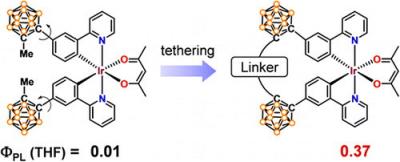Researchers from Korea's Ulsan Institute of Technology announced that they have developed a new technique that can improve the efficiency of Iridium-doped phosphorescent emitters by more than 30 times.

The team explained that this dramatic increase in efficiency was achieved by a new method to synthesize molecules - which resulted in "stronger" molecules. More precisely, the researchers created an emitter molecule in which the two carborane units were thethered by an alkylene linker.
Comments
Now this kind of news I want to read.
Hurray for progress!
Excellent news: Just imagine what could be possible, if you would apply this trick to phosphorescent emitters with an efficiency of more than 90% and you shine the light emitted from an OLED made with such emitter onto a solar cell.
Universal Display routinely claims that the internal quantum efficiency of its emitters is close to 100%. (Not all the light leaves the material as I understand it, but I think this statistic is meant to say the molecules themselves are working quite well.) So how can any molecule be 3000% more efficient than materials that are already nearly at 100% quantum efficiency? Can anyone explain in a manner that non-scientists can understand?
Efficiency was increased from very low to not unusually low.
could be currency efficiency. current common phosphor dopant with quantum eff.>50%, times 30 is 1500%, means 1 electron will generate 15 photons.....
It says it in the diagram. To start with photoluminescence efficiency was 0.01, which was increased to 0.37 by the linker. Commercial OLED materials are routinely 0.9-1.0 in this metric. In other words the linker improves performance from "truly terrible" to "pretty rubbish". Nothing to see here.
if one electron makes 15 photons
and you use a solar cell (20% efficient) to convert 15 photons to 3 electrons,
then you have 3 electrons turned into 45 photons,
which in turn produce 9 electrons by that solar cell,
...
or maybe it is just current efficiency as you pointed out.
You got it
There's no free lunch here. no perpetual machines. you can't put a propeller on a car and power the engine with wind as you drive. You can't emit light from a power source and recollect it with a collector and exceed the power consumed... by a long shot.
Rudolf Clausius already stated:
"The energy of the universe is constant.
The entropy of the universe tends to a maximum."
When Clausius realized, that beeing an acclaimed physicist does not result in lunch invitations he reformulated the principles of thermodynamics to
"There's no free lunch (even not in academia)."
I guess this pretty much sums up the highlighted paper.


I don't understand the science, but if this is true, it constitutes a huge advance for OLED displays. Thankfully ULSAN IoT has ties with Samsung, which could imply commercialization of such technologies in the not-impossibly-distant future.
Thanks for the story! I look forward to reading more.